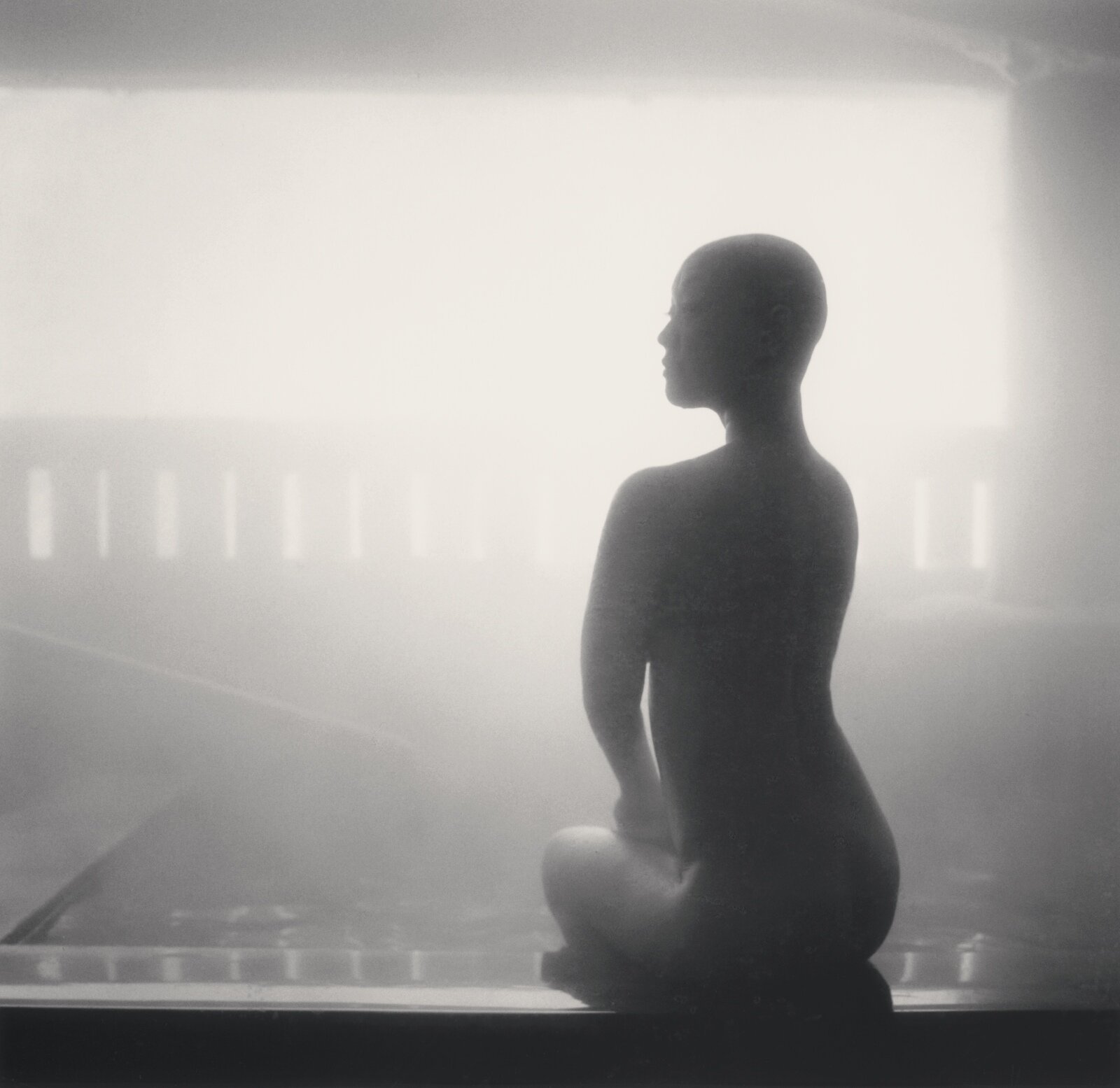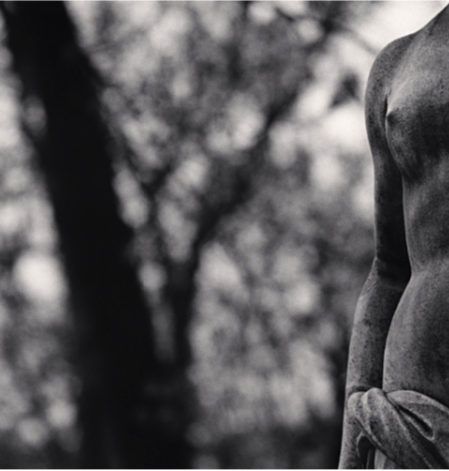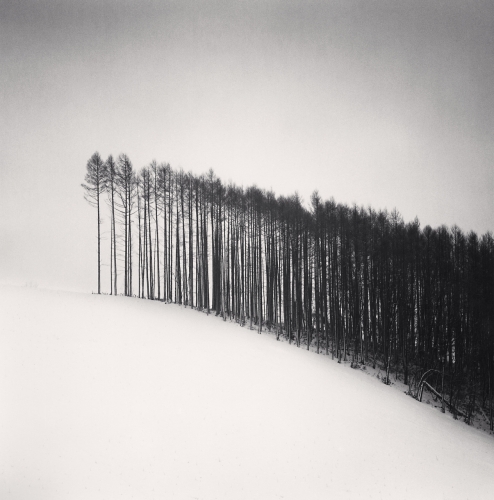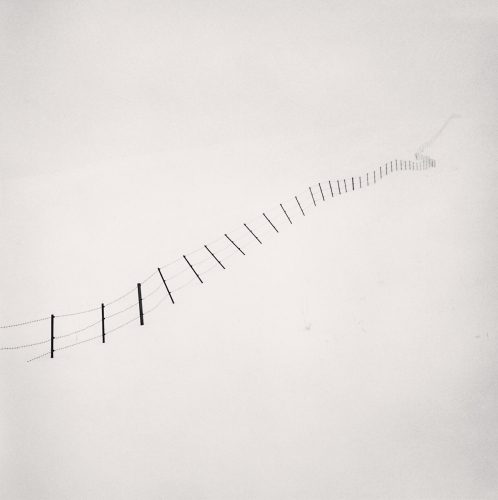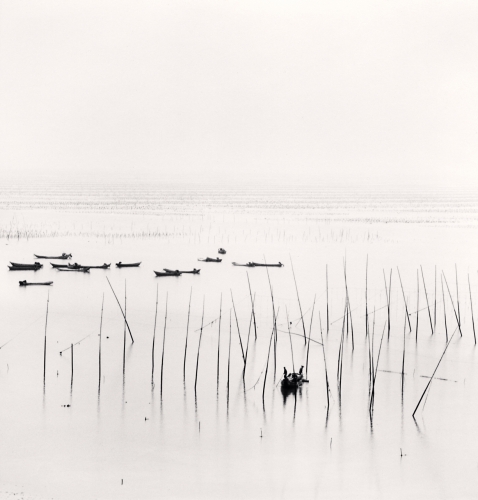Michael Kenna
Michael Kenna is a renowned photographer whose captivating images have enchanted audiences around the world. With a career spanning over four decades, Kenna's work is characterized by its poetic beauty, simplicity, and elegance. His mastery of composition, light, and shadow imbues his photographs with a contemplative and serene quality that invites the viewer to immerse themselves in the scene before them.
Kenna's oeuvre encompasses a wide range of subject matter, including landscapes, architecture, industrial sites and nudes. His black and white photographs capture the essence of his subjects, revealing their intrinsic beauty and hidden depths. Through his lens, even the most mundane or overlooked objects and places are transformed into something extraordinary.
Kenna's photographs have been exhibited in prestigious galleries and museums worldwide, and his work is held in numerous public and private collections. He has published over 200 books and monographs, earning him critical acclaim and a loyal following of collectors and admirers.
With his unparalleled skill and unique vision, Michael Kenna has established himself as one of the most important photographers of our time, and his legacy will undoubtedly endure for generations to come.
RAFU
[Rafu (裸婦), the Japanese word for unclothed female, a woman in the nude.]
For over thirty years, Michael Kenna has photographed temples, shrines, gardens, seascapes and landscapes, in black and white, throughout Japan. Ten years ago, he also began to photograph female nudes in various locations in Japan. A selection of these photographs was unveiled to the public for the first time at Paris Photo in November 2018.
The Japanese women who modelled were actresses, dancers, office workers, photographers and yoga practitioners. “Their willingness to express themselves in front of the camera and their trust in my integrity as a photographer, enabled us to engage in creative visual explorations and conversations”, says Kenna. “The human body is an absolutely amazing, mysterious miracle in a myriad of ways”, adds the British photographer. “I view both historical and contemporary creative representations of the nude as open invitations to explore this aesthetic challenge. My efforts may add little or nothing to the enormous existing mountain of artistic treasures, but that is not important. This is another chapter in an ongoing story”.
“The beauty of the body reflects the purity of the soul.”
In photography’s 180-year history the body has always been present. Daguerre himself and his circle took nude photographs between 1837 and 1840. Due to the extremely long exposure they originally used small scale copies of Roman and Greek sculptures before live models could replace them when exposure time could be measured in seconds rather than minutes. This slice of history is expressed in the curation of Michael Kenna’s prints by combining his photographs of sculptures and female nudes. His nude series, titled ‘Rafu’, is highly sculptural and yet the way he captures sculptures makes them mysteriously life-like. The women Kenna photographed are all Japanese; dancers, actresses, office workers, photographers and yoga practitioners, taken during his various visits to Japan over a 10 year period, which one could say is his spiritual home. He is almost revered as Japan’s national photographer even though he never lived there and is not Japanese himself but because of his incredible sensibility towards Japan and having photographed its temples, shrines, gardens, seascapes and landscapes for over 30 years.
“In every culture and across time, artists have been captivated by the human figure.”
Nazraeli Press is pleased to announce the publication of Kenna’s Japanese nude studies, entitled Rafu. Beautifully printed on uncoated Japanese art paper, and hand-bound in deep purple silk, this gorgeous artist’s book presents 42 images from the Rafu series. The first printing is limited to 1,000 copies. A special slipcased edition, individually numbered and signed by the artist, is available here > A deluxe edition of 25 copies, including a gelatin silver print made by the artist and presented with a copy of the book in a custom clamshell box, is available here >
Rafu was published to coincide with a major retrospective exhibition of Michael Kenna’s photographic work at the Tokyo Metropolitan Museum of Photographic Art.
Michael Kenna
Michael Kenna is arguable today’s most important landscape photographer. His timeless monochrome images capture the inner essence of nature’s beauty. Kenna filters reality through long time exposures, which create ‘empty’ space, reminding us of Chinese ink paintings. When photographing, Kenna looks for simplicity of lines and interesting abstract forms. As per Kenna’s own words: “I don’t need to be fast, I don’t need high definition, I don’t need to see the world in colour - that’s what we see all the time. I want my work to be mysterious, an interpretation, a catalyst for one’s imagination.”
Michael Kenna is one of those rare people who have resisted the fast pace dictated to us in today’s rushed city life. Kenna prefers to take his time and work alone... slowly. He has been doing this for over forty years. When he explores a new location he never knows ahead of time how long he will be there: a few minutes, some hours or days. He often returns to the same place repeatedly over a long period of time. As Kenna says: “It’s like connecting with a friend; you never know how long a conversation will last and which area the conversation will go into.” This attitude extends to his working method in the darkroom. Kenna still works in analogue only. He photographs primarily with Hasselblad film cameras and spends hours in the darkroom developing the perfect photographic print as if he was chiseling a sculpture. The resulting atmospheric imagery expresses a unique zen-like tranquility.
Initially influenced by the European masters Bill Brandt, Eugene Atget and Josef Sudek, Kenna has been photographing in Asia since the mid eighties, particularly in Japan, and more recently in China, India, Korea, Thailand and Vietnam. He admits to being strongly influenced by the sense of serenity and calmness in the Asian landscape. It harkens back to the essence of haiku poetry, the power of suggestion over description. “I’ve also looked at Asian calligraphy and traditional sumi-e paintings. These artworks have been very influential. My style has grown increasingly more minimal and sparse”.
Michael Kenna 是當今最有影響力的黑白風景攝影師之一,其歷久不衰的黑白影像捕捉了大自然美麗的內在本質。Michael 通過長時間曝光手法把現實過濾,從而創造出更「虛無」的空間,令我們聯想起中國水墨畫。Michael 拍攝時會尋求線條的簡潔和有趣的抽象形式:「我不需要快捷,我不需要高清晰度,我不需要看到彩色的世界-因為這是我們一直以來都看到的。我希望自己的作品帶來神秘感和闡釋力,成為想像力的催化劑。」
在當今匆忙的城市生活中,Michael Kenna 是難得一見的藝術家以創作去抵制我們日常的快速步伐。Michael 喜歡放慢速度,獨自一人默默工作,四十多年如是這樣。當探索一個新的拍攝位置時,他從來不會知道自己將待多久:數分鐘、數小時或數天。他經常在一段長時間內反復來回同一地方。正如他所說:「這就像與朋友聯繫,你永遠不會知道對話將持續多久,以及對話將帶領你進入那個區域。」這種態度延伸至他在黑房內的工作模式。 Michael 仍然採用底片創作,他主要使用哈蘇底片相機進行拍攝,並在黑房內花數小時去創造出完美的攝影作品,好像他在雕刻雕塑一樣,成就出他作品中那恬靜的氛圍,表現出那獨特而充滿禪意的寧靜畫面。
Michael 最初受到歐洲攝影大師Bill Brandt、Eugene Atget和Josef Sudek的啟發,自八十年代中期開始在亞洲區,尤其是在日本拍攝;近年較常到訪中國、印度、韓國、泰國和越南等地。他承認自己深受亞洲風光的恬靜感影響。他所創作的作品有如詩詞的精髓,帶有一種以暗示勝於描述的力量。「我還研究了亞洲書法和傳統墨絵畫。這些藝術品具有影響力,令我的風格變得越來越簡約和疏落。」
About Michael Kenna:
Michael Kenna was born in 1953 in Widnes, Lancashire, England, just 12 miles from Liverpool. At the young age of 10 he felt a calling to a more ascetic life and his parents enrolled him at nearby St Joseph’s College, Upholland. This was a junior seminary school and Michael trained to be a Catholic priest until he was 18. Spirituality and meditation were important parts of his education. Reaching puberty age, Michael realised the life of a celibate priest was not his vocation. He continued his studies at the Banbury School of Art (1972-73) and finally graduated in photography at the London College of Printing (1973-1976).
In 1976 he first experienced the art gallery scene in New York and a few years later he moved from the UK to San Francisco where, for a while, he took any job he could to survive. However, he particularly enjoyed his years assisting the famous West Coast photographer Ruth Bernhard. Kenna spent numerous hours working with her and learning from her to perfect the craft of analogue printing.
A breakthrough happened in 1981 when he received the Imogen Cunningham Award and subsequently sold out a major exhibition at The Stephen Wirtz Gallery, San Francisco. Since then, there have been close to 400 solo exhibitions of Michael Kenna’s work in galleries and museums throughout the world. Kenna has had over 50 books published on his work and has won numerous awards including the “Chevalier of the Order of Arts and Letters by the Ministry of Culture, France. His limited edition fine art photographic prints are in the permanent collections of such important institutions as the National Gallery, Washington, D.C., (USA), the National Museum of Modern Art, Paris, (France), the Victoria and Albert Museum, London, (England), the Shanghai Art Museum, Shanghai, (China), the Tokyo Metropolitan Museum of Photography, Tokyo, (Japan) and many others.
Michael Kenna currently resides in Seattle, Washington, USA.
Michael Kenna 於1953年出生於英格蘭,蘭開夏郡的威德尼斯,距離利物浦僅12英里。在10歲那年,他感受到了一種禁慾生活的呼喚,他父母帶他入讀Upholland的St Joseph’s College,那是一所初中的神學院;直到18歲以前,Michael 都在此受訓以成為天主教神父。靈性和冥想是組成他受教育的重要部分。到了青春期,Michael 意識到牧師獨善其身的生活並非他追求的職業。他轉到Banbury School of Art(1972-73)繼續他的學業,最後畢業於London College of Printing(1973-1976)的專業攝影課程。於1976年,他首次體驗了紐約的美術館,數年後,他從英國搬家到三藩市,並在那裡從事了不同他工作以維持生計。當中,他特別喜歡協助著名的西岸攝影師 Ruth Bernhard 工作。Michael 花了許多時間與她合作,並向她學習黑白底片拍攝的工藝。
1981年出現了 Michael Kenna 事業上的突破點,他獲得了Imogen Cunningham獎項,隨後在三藩市的The Stephen Wirtz Gallery舉辦大型展覽。從那時開始,Michael 在全球的美術館和博物館舉辦了接近四百個個人展覽,出版了五十多本著作,並獲得無數獎項,包括法國文化部頒發的Chevalier of the Order of Arts and Letters。他的限量印刷藝術攝影作品被世界各地的美術館和博物館收藏,如National Gallery, Washington, D.C., (USA), the National Museum of Modern Art, Paris, (France), the Victoria and Albert Museum, London, (England), the Shanghai Art Museum, Shanghai, (China), the Tokyo Metropolitan Museum of Photography, Tokyo, (Japan),多不勝數。
目前Michael Kenna 居於美國華盛頓州的西雅圖。
Japan (selected highlight)
China (selected highlights)
Hong Kong
Kussharo Lake Tree
Michael Kenna, Kussharo Lake Tree, Study 9, Kotan, Hokkaido, Japan. 2009. Silver Gelatin Print, Edition of 45
Here is the story behind the tree in Kenna's own words. It is the perfect accompaniment to his photos.
"In the winter of 2002, I was most fortunate to have a serendipitous meeting with a glorious Japanese Oak on the banks of Kussharo Lake, Hokkaido, Japan. That particular morning was brutally cold with heavy snow falling relentlessly. The lake was completely frozen over and white. I remember the muffled silence of the place, broken only by the piercing calls of hungry swans as they slid across the ice.
"I have photographed many trees, but this one had a special character. Like an oversized bonsai - elegant and graphically powerful. There was something quintessentially Japanese in its shape, rather like a woodblock print. Looking through the camera viewfinder, I could imagine red kanji characters descending down one side of the photographic frame. My imagination conjured up a wise, old woman bent over the lake. I wondered what she must have observed from her keen vantage point over the many years she had been there.
"Since that first encounter, I returned to make photographic portraits of the tree whenever I could. Between my visits, branches broke and fell. To my eyes, this aging tree remained graceful and resilient. I began to regard her as a dear friend and I greatly looked forward to our many reunions.
Michael Kenna, Kussharo Lake Tree, Study 5, Kotan, Hokkaido, Japan. 2007. Silver Gelatin Print. Edition of 45.
"Then, in August 2009, the tree was suddenly cut down. Apparently, she was situated on the edge of a camp site and there was concern that people who climbed on her could fall into the water if more branches broke. The demise of the tree was reported in Hokkaido newspapers - somehow it had become quite well known as 'Kenna’s Tree'. Despite my sadness, this sweet association made me smile.
"I did not visit Kussharo Lake again until February 2013, when I finally made a return pilgrimage. It was as cold and frozen as my first visit. Of course, the tree was no longer there. Just an empty space where my tree had stood serenely for all those years. But the hungry swans still called out in their haunting manner for their morning food, and the lake was once again iced over, silent and still.
"Time passes, change inevitably occurs, friends come and go, and yet, in a curious way, things stay the same. I have extremely fond memories of this secluded winter hide-out, the home of the lovely Kussharo Lake Tree. I will surely return there in the future to walk, listen, remember, and perhaps photograph some more."
As featured by My Modern Met.
屈斜路湖樹
Michael Kenna 親自分享拍攝的背後故事,成為他作品的最完美伴奏。
「2002年的冬天,我有幸地在日本北海道的屈斜路湖畔,與那美好的日本橡樹進行了一次偶然的會晤。那早晨冷得殘酷,大雪無情地落下。我記得這個地方充斥悶悶不樂的寂靜,唯獨被飢餓的天鵝在冰上滑行時發出的刺耳叫聲打破。 我拍過很多樹,但這棵卻帶有一種獨特的個性。它就像一棵巨大的盆景-優雅而輪廓分明。那典型的日式形狀,有如木刻版畫;當我透過相機觀景器看,我想像得到一列紅色漢字出現在照片框的一側。我聯想到一位老婦人在湖邊彎腰,我好奇她待在那裡的這些年來,從她敏銳的視角會觀察到甚麼。
自第一次相遇以來,我盡可能地再次回去拍攝這棵樹。在拜訪之間,它的樹枝斷掉了。但於我而見,這棵老樹仍然優雅而富有恢復力。我開始視她為親愛的朋友,我極之期待我們更多的會晤。然而,在2009年8月,這棵樹突然被砍倒了。顯然地,她位於營地的邊緣,人們擔心如果有更多的樹枝折斷,爬上去的人可能意外掉入水中。北海道的報紙曾報導過這棵樹-不知何故她被稱為「Kenna’s Tree」。儘管我非常悲傷,但這種甜蜜的聯想使我會心微笑。
直到2013年2月,我才終於再次返回屈斜路湖朝聖,那次跟我第一次拜訪一樣天寒地凍。但當然,樹已不復存在,那一處虛空只剩下她多年來平靜的曾經,然而飢餓的天鵝仍然纏綿地呼喚牠們的早餐,湖再次被冰封,寂靜無聲。 隨著時間流逝,變化無可避免地發生,朋友們來的來、去的去;然而,在一種奇怪的方式下,事情卻保持不變。我對這個僻靜的冬季藏身處-那可愛屈斜路湖樹的家-有著極其美好的回憶。我將來肯定會再次回到那裡,去漫步、去聆聽、去牢牢記住,或許還會拍些照片。」
轉載自《My Modern Met》。
Videos and Interviews:
Short profile on the photography and techniques of Michael Kenna.
Michael Kenna as discussed by Ted Forbes from 'the Art of Photography'.
Press Received:
2016-9 | SCMP: 'From Altarboy to Photographer'
2016-8 | Looking Glass 'Michael Kenna: A man with a camera'
2015-11 | Handelszeitung 'Stille Kraft'
2015-10 | Die Welt (Germany) 'Auf Worte ist kein Verlass'
2015-9 | Spiegel (Germany) 'Verführerisch, wild und hoffnungslos romantisch'
2014-1o | Fotografia 'Con el poder de un haiku'
2014-8 | 「中國」Michael Kenna 個人攝影作品展覽 Timable 事件
2014-8 | SCMP - 48 Hours 'Prints Charming'
2014-7 | City Magazine 'Michael Kenna - Photo Feature'
2014-7 | Digi BiWeekly
2014-7 | Art Daily 'Michael Kenna's first solo exhibition at AO Vertical Gallery HK'
2014-7 | Feature Shoot : 'Photo Du Jour: Tranquility in China'
If you wish to receive Michael Kenna’s e-catalog with more information regards available prints and prices, please submit the form here below and we will revert real soon.




